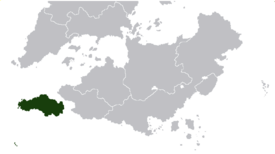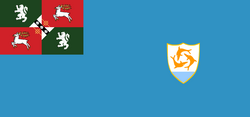Satavia: Difference between revisions
No edit summary |
No edit summary |
||
| Line 156: | Line 156: | ||
Satavia is a {{wpl|parliamentary republic}}, previously having no written constitution until the 1935 [[February Coup]]. Satavia's seperation of powers extends to the {{wpl|judiciary}}, {{wpl|executive}} and {{wpl|legislature}}. Satavia's head of state is, legally, the [[Governor-General of Satavia|Governor-General]], however, in practice the position holds no power whatsoever, and powers usually vested in a head of state are invested in Satavia's head of governemnt, the [[Prime Minister of Satavia|Prime Minister]]. Like the majority of Estmere's former colonies, Satavia loosely follows the {{wpl|Westminster System|Northabbey Model}}. | Satavia is a {{wpl|parliamentary republic}}, previously having no written constitution until the 1935 [[February Coup]]. Satavia's seperation of powers extends to the {{wpl|judiciary}}, {{wpl|executive}} and {{wpl|legislature}}. Satavia's head of state is, legally, the [[Governor-General of Satavia|Governor-General]], however, in practice the position holds no power whatsoever, and powers usually vested in a head of state are invested in Satavia's head of governemnt, the [[Prime Minister of Satavia|Prime Minister]]. Like the majority of Estmere's former colonies, Satavia loosely follows the {{wpl|Westminster System|Northabbey Model}}. | ||
The [[ | The [[Parliament of Satavia]], Satavia's bicameral legislature, is made up of the [[House of Representatives]], the directly-elected lower house, and the [[County Court]], made up, in part, by unelected {{wpl|peers}} (however, succesive Government's have kept a policy of not awarding new peerages) and, the majority, as [[County Court|County Senators]], who are elected every 5 years (with the exception of counties in Ballyliegh, where it is 7 years). The County Court is Satavia's upper house, and has the power to review and refuse to pass legislation, where it then gets returned to the House of Representatives to be ammended. | ||
===Electoral System=== | ===Electoral System=== | ||
Revision as of 17:21, 28 November 2020
This article is incomplete because it is pending further input from participants, or it is a work-in-progress by one author. Please comment on this article's talk page to share your input, comments and questions. Note: To contribute to this article, you may need to seek help from the author(s) of this page. |
Republic of Satavia | |
|---|---|
Anthem: All Earthly Things Above Alle aardse dingen hierboven | |
 Location of Satavia, in Green, in Asteria Inferior | |
| Capital and largest city | Port Hope |
| Official languages | Estmerish Hennish |
| Recognised national languages | Dupowek |
| Ethnic groups (2015) | |
| Demonym(s) | Satavian |
| Government | Parliamentary Republic |
| Arthur Livingstone-Scott | |
| Jago Elliot | |
| Legislature | Parliament of Satavia |
| County Court | |
| House of Representatives | |
| Establishment | |
• First Trade Posts set up by the South Asterian Company | 1548 |
• Colonisation by the Sotirian Commonwealth | 1649 |
• Transfer to Estmere | 1747 |
• Dissolution of Estmerish Asteria, and foundation of the Hope Territory | 1778 |
• Officialy becomes a colony, forming the Estmerish Hope Colony | 1782 |
• Home Rule Granted (Hope Colony Home Rule (Dominion) Act 1816) | 1816 |
• Decleration of Independence | 1st January, 1900 |
| Area | |
• Total | 663,130 km2 (256,040 sq mi) |
| Population | |
• 2018 estimate | 21,501,500 |
| GDP (nominal) | 2015 estimate |
• Total | $462.2 Billion |
• Per capita | $21,500 |
| Gini (2015) | medium |
| HDI (2015) | high |
| Currency | Satavian Guilders |
| Time zone | UTC+ 11 (Satavian Standard Time) |
| Date format | dd.mm.yyyy |
| Driving side | left |
| Calling code | +47 |
| Internet TLD | .sa |
Satavia, officially the Republic of Satavia (Hennish: Republiek Satavia), is an Island Nation in Western Asteria Inferior, and shares a Maritime Border with Nuvania. Satavia consists of the Satavian Isles and the Patrick Islands, an autonomus dependency of Satavia. The capital, largest city and biggest financial center is Port Hope, which had previously been known as Hope Town. Satavia is made up of 6 historical provinces, namely Hope Province, Northern Hope, Andersland, Dukeminster, Camburton Province and Ballyleigh and 22 counties.
The Head of Government is the Prime Minister of Satavia, who wields almost all powers of Government and effectively acts as both Head of Government and Head of State, although officially the Governor-General of Satavia is the Head of State. Like Governors and the Lieutenant Governors, the Governor-General is a merely symbolic role. Whilst the Governor-General does, officially, appoint the Prime Minister, the Prime Minister does not, in practice, report to the Governor-General. The Governor-General is retained due to the Cease Fire and Normalisation of Civil Relations Act, 1983 which saw what is commonly called "The Monarchy Compromise" that ended the Satavian Crisis, and saw the eventual end of effective one-party rule in Satavia.
Satavia was one of the last countries in the Asterias to gain independence, doing so in 1900. In a 2012 Referendum, 67.44% voted to restore the pre-republican flag of Satavia, and replace the Republican Flag.
Etymology
History
Pre-Historical
Colonisation Period
The First Hennish Republic and their South Asterian Company first established trade posts along the Satavian Coast in 1544, four years after both the Duchy of Flamia and the First Hennish Republic had established trade posts along the Nuvanian Coast. By 1548 at the earliest[1], the Duchy of Flamia, with their New Asterian Company, began colonising Satavia. However, in 1552, the Duchy abandoned their trade posts after a short, undeclared conflict which ended their involvement in Satavia. All of these trade posts are now uninhabited, with the majority having been destroyed or dismantled.
In 1649, the Sotirian Commonwealth officially took over the South Asterian Comapany's remaining trade posts. This saw a period of inactivity in Satavia, untill the Grand Duchy of Flamia was established in 1719, which heralded a change of administration and an influx of cheap labour, paticularly from Bahia. The Grand Duchy's conquering of Commonwealth settlements in Satavia and Nuvania saw the creation of Flamian Asteria.
Following the Estmerish-Hennish War, the colony was transfered to Estmere, who created Estmerish Asteria. This was disolved in 1778, creating instead Nuvania (a colony) and the Hope Teritory. This short-lived teritory would be succeeded by the Estmerish Hope, also called the Hope Colony in 1782. The Estmerish period would see a booming population and industry, a reason often attributed to Satavia's politicians reluctance to seek independence from Estmere, unlike their Nuvanian counterparts. The period also saw extensive Estmerisation, which saw the majority of the populace starting to speak Estmerish, as opposed to Hennish.
In 1811, Nuvania was granted home rule, to be followed by Satavia five years later in 1816, under the Hope Colony Home Rule (Dominion) Act 1816. The Estmerish Hope became the Hope Dominion, and in 1816 it's first Prime Minister, Richard Somerset, was appointed. The next sixty years would see a period of rapid growth and self sustainability, with Satavia beginning to trade with Nuvania more than Estmere. This would be shattered following the War of the Arucian, which Satavia was not involved in, but following Nuvania's victory and then decleration of independence would lead to a decline in trade with Satavia and the eventual economic crash in the form of the Satavian Recession of 1893. Estmere's lack of interest in helping the Dominion lead to Satavian leaders asking for independence. 1893 also saw the first Satavian Governor actually from Satavia, unlike previous Governors who had all been from Estmere. Following a series of bilateral talks with the Estmerish Government, and the rejection by Satavian leaders to be 'equal partners' with Estmere and Satavia sharing a Monarch, a deal was reached in that Satavia's Governor, a cousin of the King of Estmere, Patrick, would be made King Patrick I. On the 1st of January, 1900, Satavia became the last major colony in the Asterias to declare independence.
Kingdom of Satavia
• Patrick I Proclaimed King of Satavia
Great War
• Need to check Satavia's involvement (possibly prommised money?)
February Coup
Satavian Crisis
The Satavian Crisis was a period of sectarian political violence in Satavia that lasted from 1973 until 1983, with the Cease Fire and Normalisation of Civil Relations Act, 1983 which ended the government's state of emergency and saw an effective end to all fighting in Satavia. The collapse of the Second Bleum Government in 1976 lead to the establishment of a caretaker government lead by Arthur Elliot. Following the 1976 Republican Election, a non-Republican Party government was established, the first since 1935, which saw the end of the Satavian Republican Period and the re-classification of Satavia from an "effective one-party state" to a "multi-party parliamentary democracy" with the Community of Nations and the International Council for Democracy.
Initial violence erupted in 1973, following the introduction of the 1973 Satavian Constitutional Amendments which clamped down on anti-republican sentiment and was introduced by far-right Republican Party leader and Prime Minister Dick Bleum. Violence was started by the Free Satavian Army, who advocated for a return to "real democracy", with their attempted assasination of Bleum. Soon after, Monarchist Paramilitiaries began a campaign of terror.
Several attacks in 1976, and the 1976 Satavian Riots lead to the complete collapse of the Republican Government, and the introduction of a caretaker government. 41 years of single-party rule ended, and following the 1976 General Election, lead to the first SDP government.
Recent History
Geography
Climate
Government & Politics
|
Government Conservative: 142 seats Opposition SDP: 37 seats Liberals: 17 seats Independent Labour: 29 seats Green: 1 seat Republican Party: 11 seats Monarchist: 9 seats Socialist People's Party: 1 seat Independents: 2 seats |
Satavia is a parliamentary republic, previously having no written constitution until the 1935 February Coup. Satavia's seperation of powers extends to the judiciary, executive and legislature. Satavia's head of state is, legally, the Governor-General, however, in practice the position holds no power whatsoever, and powers usually vested in a head of state are invested in Satavia's head of governemnt, the Prime Minister. Like the majority of Estmere's former colonies, Satavia loosely follows the Northabbey Model.
The Parliament of Satavia, Satavia's bicameral legislature, is made up of the House of Representatives, the directly-elected lower house, and the County Court, made up, in part, by unelected peers (however, succesive Government's have kept a policy of not awarding new peerages) and, the majority, as County Senators, who are elected every 5 years (with the exception of counties in Ballyliegh, where it is 7 years). The County Court is Satavia's upper house, and has the power to review and refuse to pass legislation, where it then gets returned to the House of Representatives to be ammended.
Electoral System
Administrative Divisions
Province
Satavia is divided into six provinces, the Hope Province, Northern Hope, Andersland, Dukeminster, Camburton Province and Ballyleigh, with Camburton Province being the least populous (with 77,392 people in 2008), and the Hope Province being the most populous (with just over 9.5 million people, of which four million live in Port Hope.
Until 2008, there were seven provinces, but the two smallest (the Upper Highlands and the Lower Highlands) were amalgamated into the newly-formed Camburton Province. Provinces are merely symbolic, and described officially as "Historic Provinces". Each province has a Governor-General, directly subordinate to the Governor-General of Satavia. Often these posts are given to former Prime Ministers and politicians, with two former politicians, Johan de Vilock and Charles Hisloep-Freeke currently holding the position of governor of the Hope Province and Andersland respectively.
Satavia's Emergency Services opperate along provincial boundaries, with the Hope Province Fire Service operating in both the Hope Province and Northern Hope, whilst the Andersland Fire Service, Dukeminster Fire Service and the Balleyleigh and Camburton Fire Service all operate along provincial borders.
| Province | Provincial Town | Population | Governor | ||||
|---|---|---|---|---|---|---|---|
| Port Hope | 9,549,162 | Governor of the Hope Province | |||||
| Adamstown | 3,999,748 | Governor of the Nothern Hope | |||||
| Northhaven | 1,051,713 | Governor of Andersland | |||||
| Kingsleigh | 988,345 | Governor of Dukeminster | |||||
| Camburton | 77,392 | Governor of Camburton Province | |||||
| Port Arthur | 5,722,539 | Governor of Ballyleigh Province | |||||
County
Satavia's second teir subdivision are counties (and, more recently, metropolitan areas), which were established over time during the colonisation of Satavia. Most counties have a Lieutenant Governor, directly subordinate to the Governor of their respective province (with the exception of the Patrick Islands, whose Lieutenant Governor reports to the Governor-General of Satavia), County Camburton has County Sheriff, and a couple have a County Council Executive. The Metropolitan Area of Adamstown has a Mayor, whilst Port Arthur, Port Edward and Port Hope all have a "Commander of the Garrison", with the Commander of the Garrison at Port Hope being ex officio held by the Governor of the Hope Province.
These Lieutenant Governors hold no power and are merely symbolic roles - Counties without a Lieutenant Governor have an elected representative (Lieutenant Governors are appointed by the Governor of the respective province, and are not elected). Counties with a Lieutenant Governor also have an elected representative, but the Lieutenant Governor remains the ceremonial head of the county.
Districts
The third and lowest level subdivision is the District. Districts are smaller than counties, and are somewhat comparable to a municipality. Districts are usually run by a town council, or something to a similar effect. There are 289 districts in Satavia, many of which are called 'boroughs', most of which are in cities, however, some are located ruraly - albeit this is rarer.
Military
Foreign Affairs & International Standing
- ↑ Sources vary on when the Duchy of Flamia began colonising Satavia, but the majority imply that it was around 1548






